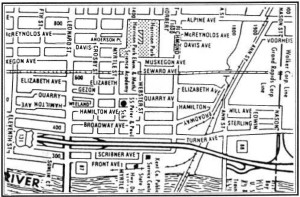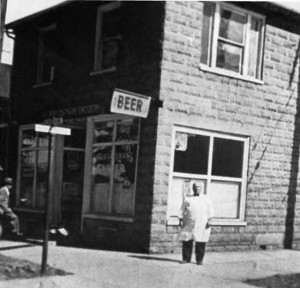
The Saga of a Lithuanian Flying Machine
Edward V. Gillis (Gylys) is the author of the still unpublished book, Growing Up Lithuanian in Old Lithuanian Town of Grand Rapids, Michigan. The book of over 500 manuscript pages deals with Lithuanian life in Grand Rapids from 1885 to 1940 and is illustrated with some 200 early photographs. The author has spent immeasurable hours in the research and preparation of this work. This story was excerpted from the book.
JOHN SABAITIS WAS BORN IN SUVALKU GUBERNIA, in southwestern Lithuania on October 10,1882, and was 85 years old when he died in Grand Rapid’s Lithuanian Town on March 30, 1967. He was the son of Joseph and Mary Sabaitis. John remained in Lithuania after his mother and father emigrated to America. He continued his education in Lithuania, but is it not known how many grades he completed. John was able to read and write both in Lithuanian and Russian, and was also able to speak German, Polish, Latvian and Yiddish.

calls “Old Lithuanian Town.”
John Sabaitis was 27 years old when he arrived in America in 1909- He first settled near Pittsburgh, Pennsylvania where he soon met his bride, Anna Kapacinskas. They were married that year at St. Casimir’s Lithuanian Catholic Church in Pittsburgh, and shortly thereafter left for Grand Rapids, Michigan, arriving in Lithuanian Town in 1910.
John and Anna moved in with John’s parents who lived on the northwest corner of Hamilton and Myrtle. John’s father, Joe Sabaitis, retired from Imperial Furniture Company as a master cabinet maker. In addition to his retirement chores as the sexton at the Catholic cemetery, he was also the bell-ringer at St. Peter and Paul’s Catholic Church. Joe lived next door to the church. He also made beautiful cedar-lined wardrobes in his spare time. The cabinets featured hand-carved water lilies on the corner trim, his trademark.
Informally, John Sabaitis was never called by his given name but was most often just called “Sabi” or “Sabas.” Sometimes even “Sabuky” because of his somewhat short and stocky build. In any event, good natured John didn’t mind so long, as in the old saying, “they don’t call him late for dinner.”
Indeed, John became a legend in his own time. He can be described as very intelligent, very patient, mechanically obsessed, always thinking ahead—some would call him visionary. He was a man with lots of guts, a fighter, an entrepreneur, a good father who provided for his wife Anna and their six children, and finally, like his dad, spoke several languages. A man who “walked to his own drummer.”
According to 84-year-old Agatha (Sabaitis) Kaminskas, one of two surviving children, her dad first went to work for Malleable Iron Foundry, and then at the Galmeyer Livingston Machine Company before going into business for himself.

he built himself with cement blocks he cast and hauled to the
building site on a two wheel pushcart. The building stands to this day.
Eventually, John was able to buy a lot on the southeast corner of Richmond and Muskegon. Here he began to build his own two-story masonry building as a business place and a home. Instead of purchasing precast cement building blocks, inventive John built several molds for smooth and sculptured face cement blocks and cast his own in the back yard of his dad’s home. Agie could not remember for certain how long it took. Working endless hours and weekends, she thought it was at least three years for the main parts of the building and finishing off details after they moved in. Makes you wonder when he ate and slept!
Soon after John and Anna opened their grocery store, John became aware of the possibility of serving food to nearby Hayes Body and Knape and Vogt workers and so added a restaurant to the grocery business. In time and when prohibition ended, he once again made changes and was soon operating as a tavern as well.
Agie said that she and her sisters clerked and waited tables and remembers well when Paul Leven (who was from the west side and was living on Alpine at the time) used to frequently come into her dad’s store for penny candy. They called him “Little Paul.” “Little Paul” is much bigger now and a very successful businessman. Mr. Leven is the founder and owner of the Witmark chain of ten discount stores in western Michigan.
Among “Sabi’s” early projects was a two-passenger “Paddle Boat.” The pontoon-style craft was powered by a paddle wheel on each side of the water craft and was steered by a rudder. How original it was we do not know, but it was an eye-catcher in the early 1920s to see him paddling around the Grand River.
“Sabi’s” second project was a “Land-Water Craft,” and here again, surely the first ever seen around the Grand Rapids area. According to John Yurkinas, who with his late brother Joe were quite close to “Sabi’s” activities, “Sabi” equipped a fairly large rowboat with a motorcycle engine, a drive mechanism and gear box that allowed him to shift from land travel on three wheels to side paddle wheels. He would drive down to the mouth of Indian Mill Creek at the Grand River, then shift power to the paddles and cruise around the river. Again, this was even more of an eye-catcher than the “Paddle Boat.” John said that just as startling was to see a boat put-put-putting along the city streets. Quite often, “Sabi’s” obedient German Shepherd “Spooky” would be sitting up on the back seat, every attentive and so much like the firemen that used to sit at the back end of a ladder wagon on the way to a fire. Although “Sabi” traveled the city streets many times with his “Land-Water Craft,” he was never confronted by the police for lack of a license. (Maybe because they didn’t know what kind of vehicle to call it?).
Now to the feature of our story—“The saga of a Lithuanian Flying Machine.” I find myself unable to accurately use the right terminology in describing it. The source of power was a motorcycle engine which was geared to drive a dual set of rotary paddle wheels, one on each side of the fuselage. (Note the similarity of propulsion which was used in the “Paddle Boat” and the “Land-Water Craft.”) Each triple-bladed paddle seems to have six Venetian blind-like veins that apparently could be opened or partly closed to possibly achieve more lift or speed. Beyond the approximately 24-inch wide paddles, there were what appears to be stubby wings—approximately four feet by ten feet. The two front wheels seem to be about 24 inches in diameter motorcycle wheels. No other distinct features are visible in the photographs showing the plane.
John’s neighbor, Frank Uzas, told us that “Sabi” had to widen the doorway of his shop in order to get the plane out, and that the equally legendary “Red City Gang” considered it their special privilege to wheel the airplane out of the barn-shop for another one of its frequent “test flights.” These “test flights,” with Joe Yurkinas as the official pilot, attracted considerable local attention and speculation. Many described it as, “The engine roared while the dual paddles churned up clouds of dust, but nothing happened.” Others said, “Did you see that it’s off the ground?” One lady told us she always closed her eyes— “I was sure it was going to race away and crash.” However, it was said that no one cheered louder than the “Red City Gang” boosters who would holler: “Come on now, up, up, and away! Give her hell, Joe! Get her up!”.
It is not known just how John Sabaitis learned about the Philadelphia Air Show, whether he was invited or heard about it and just decided to go on his own. He removed the wings from his plane and loaded it onto a flat-bed truck along with his “Land-Water Craft” and headed off for Philadelphia. It was believed his pilot, Joe Yurkinas, accompanied him to Philadelphia.
According to daughter Agie, the air show officials expressed considerable interest in the tail and flap design. It is not known whether Sabaitis had some unique or radically new feature that may have been an improved engineering concept or not. In any event, John never received any official recognition. And of course, too, none of the airplane’s details were patented. Indeed, John Sabaitis may have contributed to the evolution of modern airplane tail and flap design— but we will never know, will we?
No one seems to have heard what the show officials thought about John’s “Land-Water Craft.” Here again we will never know if John’s unpatented good ideas became free for the taking. John’s idea certainly preceded the U.S. Army’s land & water crafts they called “Duck Boats” at least by 12 to 15 years. The Army’s version was able to utilize the much more efficient propeller propulsion instead of side paddles.
According to Agie, her dad spent at least eight years designing, building and testing his airplane in his workshop behind the tavern.
John Yurkinas, whose brother Joe was the pilot, said that the final days of the airplane ended shortly after their return from the Philadelphia Air Show. After some minor changes, the plane was wheeled out to Harrison Park for that yet one more “test flight.” This time, and unbelievably, Joe was unable to control the plane as for the first time it actually rose three to four feet off the ground, then as suddenly crashed to the ground with enough force to pretty much cause considerable damage. Disheartened after eight years of effort, John, who may truly have been on the verge of some degree of success, finally gave up. The broken components were hauled back to the workshop by an equally disheartened “Red City Gang Field Crew.” Eventually, the unsalvageable components were discarded.
John may have acknowledged defeat in the transportation field, but nothing could stop his obsession with tinkering in his workshop. Towards the end of the 1930s, and into the 1940s, John came up with a “Potato Planter.” It was a mechanical device that a farmer could use by simply walking along a furrow, jabbing the point of the device into the soil at a proper depth, and inserting the cut-potato seed into the soil. By extracting the tip it would cover itself up. This time, John had Rapid Engineering Company draw up the blueprints so he was able to file for a patent.
We can’t help but suspect that John maybe learned a lesson from the Philadelphia Air Show to finally protect his inventions. However, his “Potato Planter” may have been a little late. More mechanized planters were soon available.
In conclusion, so ended the saga of the “Lithuanian Flying Machine that went up, up, but not quite away!” The indomitable spirit of this exceptional Lithuanian deserves to be honored and remembered in this history of Lithuanian Town. He was a man who used every failure as a stepping stone to a better future, a man whose days were without hours, a man who stood up to laughter and sometimes ridicule, but who sought nothing but a vision in that somehow he could better the world he lived in. The size of this man can only be judged by the fact that throughout an endlessly active life, he never— like many great men — stopped to pat himself on the back! We think John is really “Flying around up there after all!”
 DRAUGAS NEWS Lithuanian World Wide News in English
DRAUGAS NEWS Lithuanian World Wide News in English
